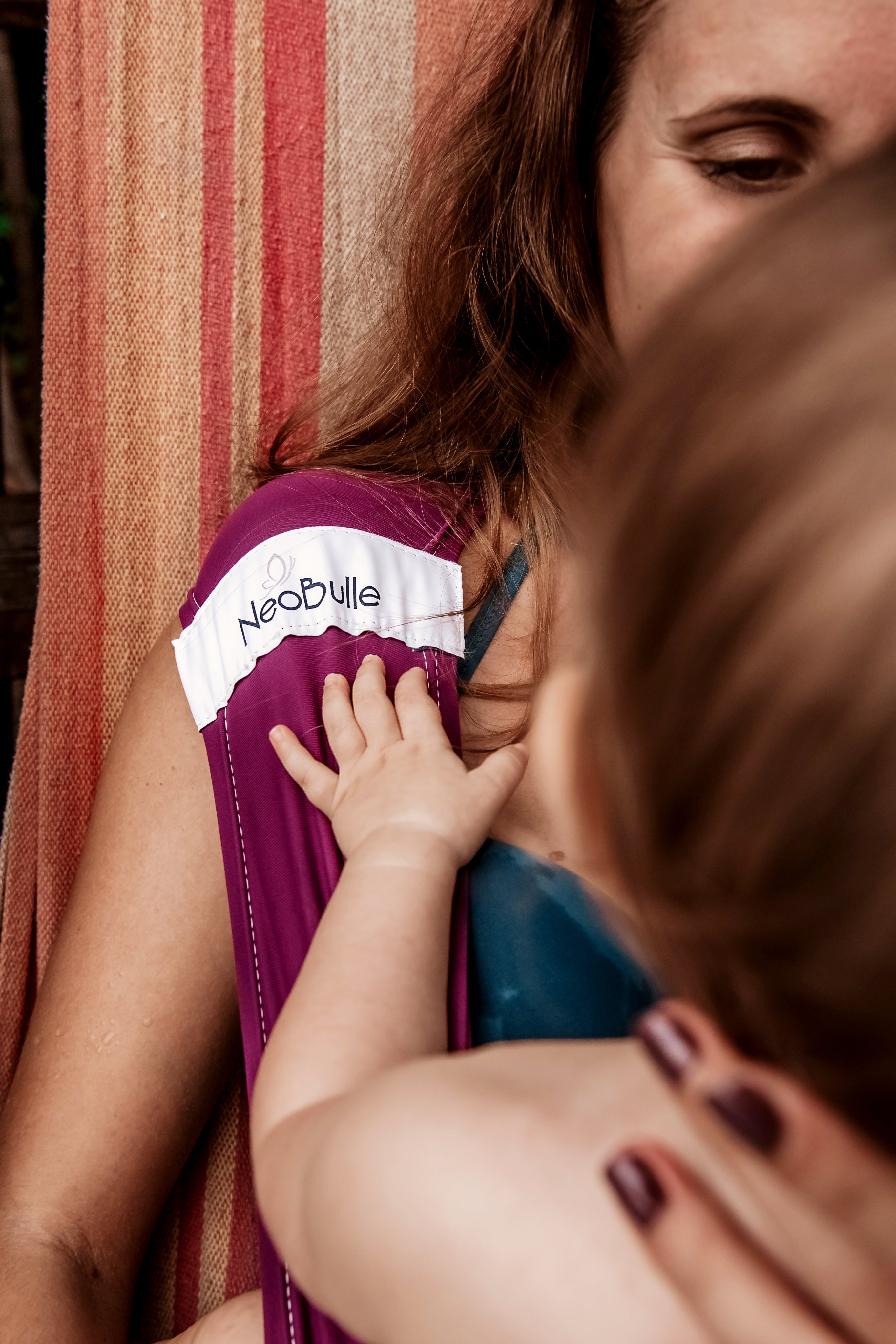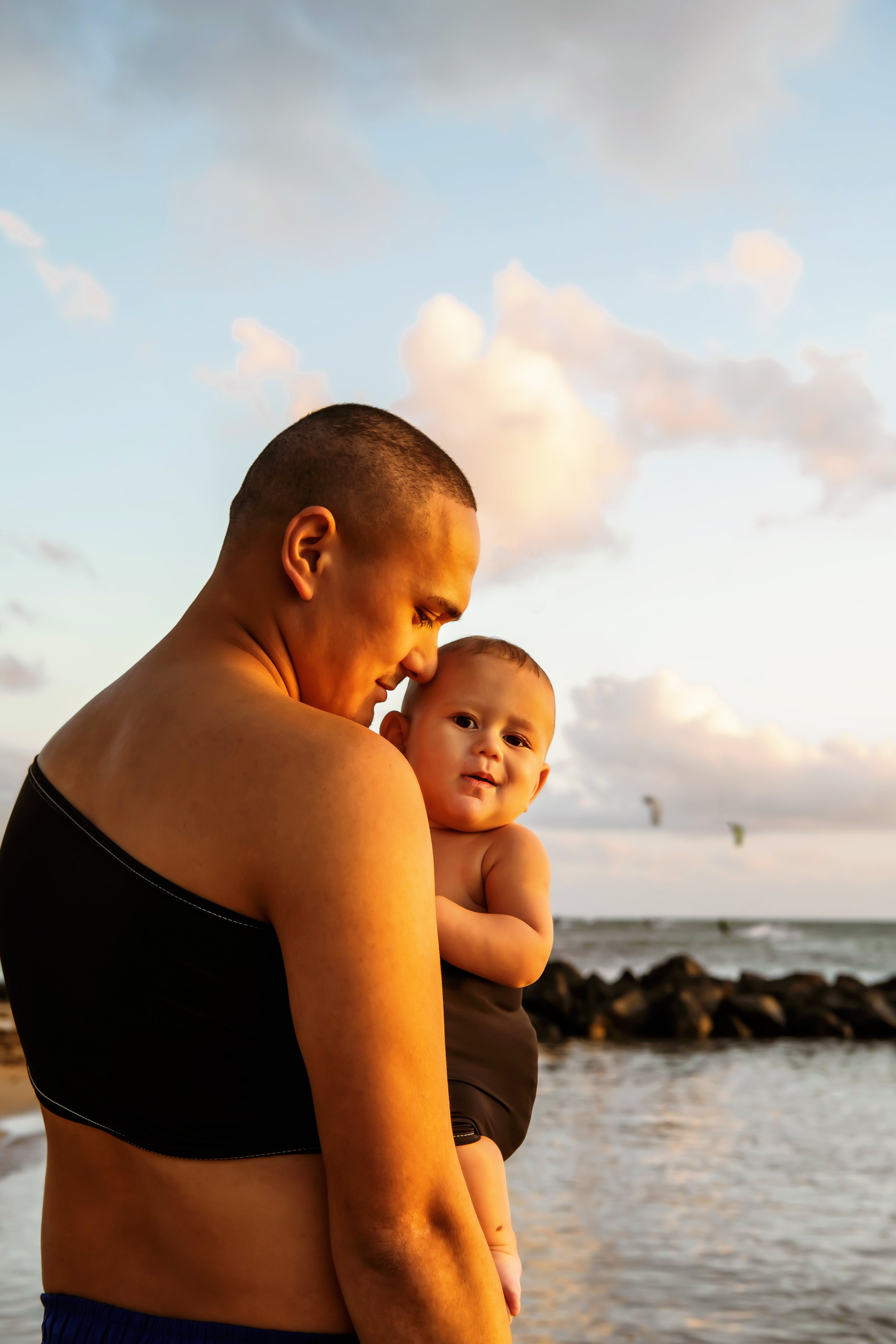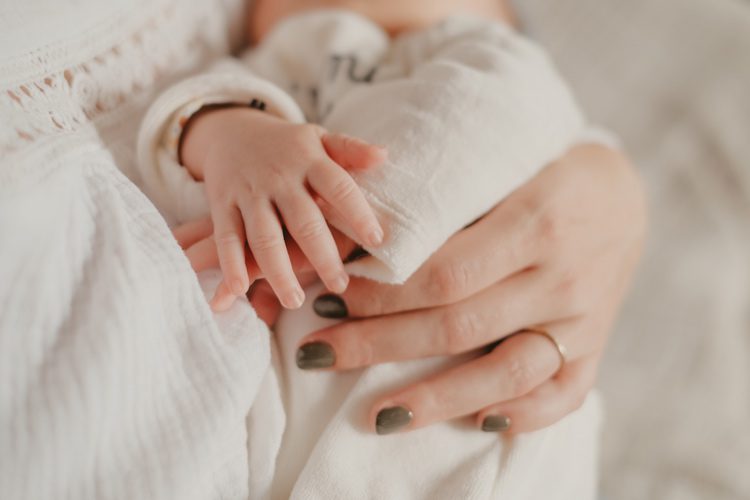
The containing touch
The benefits of massage are numerous! Touch, no matter how simple, is important for baby and their development. Touch, is already what you do when you carry them, give them a bath... There are several types of touch, and in this article, I would like to talk more specifically about the containing touch, which I find particularly magical. The containing touch is particularly suitable for many situations: For children who do not want to be massaged, for children we cannot calm down, for disorganized children, "scattered"... The technique has the advantage of being very simple. It suffices to use both hands, placing them at two opposite points on the baby's body, then applying gentle pressure while bringing our hands closer together (keeping the baby's body between our hands). This movement aims to "gather" the baby and has a calming, containing virtue... like in the mother's womb! This technique is magical: I have tested it on people of all ages and the reactions were quite surprising. With a baby who was crying and, as soon as his mother performed this touch, he stopped, started to fidget again if his mother removed her hands, and calmed down as soon as she put them back... Older, on a teenager who told me: "what you just did is great, it brought us together!". On an adult woman I performed this touch at the end of a massage session, and she told me it was her favorite moment. I think that somewhere, deep inside each of us, who has known the containing womb of our mother, this touch brings us back to something very reassuring, archaic.

A little slump in your parent role?
Do you also feel it, this routine that exhausts us, this daily grind that bores us? Everything is fine, we lack nothing, baby is in good health. And yet, between diapers, bottles or breastfeeding, laundry, meal preparations, school schedules, and obligations, we can feel that this routine puts us to sleep. So we love them dearly, huh! All of them: the little ones, the big ones, my partner... And despite this powerful love and these countless tirelessly repeated tasks, with baby snug on the hip in a sling , we get bored... and sometimes even, we feel guilty for not doing enough, for not being enough... While we don't stop for a minute! Rest assured: You are not the only person feeling this way This does not diminish your parenting skills The love you have for your family is not questioned You can join a parent support group And yes, I know... We all dream of a bit of adventure, travel, big meetings, our fulfilling great job... But motherhood and cocooning sometimes have this little imprisoning side, which could trap us in feelings of devaluation! Indeed, the society of doing, of doing quickly and showing everything to everyone, does not help to highlight the background work, invisible and repetitive, of a parent, and I would even say, of a mom... The amazing dads, I haven't forgotten you, but I am sure you will agree with me that all these daily tasks are unfortunately still not shared enough within households, and are far too often the domain, not always chosen, of women. This is all the more true during maternity or parental leave. And surely, it doesn't help either, to: Not have time to get dressed before 3 p.m., because baby keeps you busy Have dark circles under your eyes because you haven't had a full night's sleep in months Wear your maternity sweatpants because you haven't found the time to buy new pants Forget the last visit to the hairdresser... Take a shower quietly at 11 p.m. when everyone is finally asleep Never have 10 minutes alone, not even in the bathroom And I forget others! So, when you catch yourself mumbling for the umpteenth time "I still haven't had time to do anything today", know that it's not true! I invite you to list everything you accomplish and achieve during the day, believe me, you will be positively surprised by the result! Think to ask for help from your surroundings Call a resource person who will tell you how fantastic you are And when you start doubting your skills because you just broke the record for changing the 2000th diaper, don't forget that : You are the best person for your child Try to set achievable short-term goals and see them come true And of course: carrying your child can help you (see article all the times carrying saved my life) But giving birth and raising a little being, love and education, takes time! Nature does things without rushing, and yet everything is accomplished. Lao Tzu And in a system where everything goes very fast, where everything changes all the time, we sometimes tend to forget it. Let's try to cultivate values of patience, perseverance, resignation, and ... humor, always. "You are annoyed to launch a new layette machine because baby decided to redecorate all these pajamas in vomit color? Tell yourself that in 15 years, you will be hanging football socks or crop tops to dry!" And ... We can also look at this monotony from a positive angle. Because this dense and ritualized way of life allows us to juggle multiple tasks. A bit of perspective helps us see that we are getting there, come what may, day after day, without failing. And finally, when we realize that not everyone has the chance to live this cozy purr, it becomes much softer, even precious. Cooking is the factoryWhere the day is preparedWe hum, we bottle-feedThe coffee is willing to passBread slices, bootsWe do everything at the same timeWe dress one or two girlsThe day has begunMechanical workIn the morning gesturesThe gestures we know wellIt's nothing, it's daily happiness Anne Sylvestre
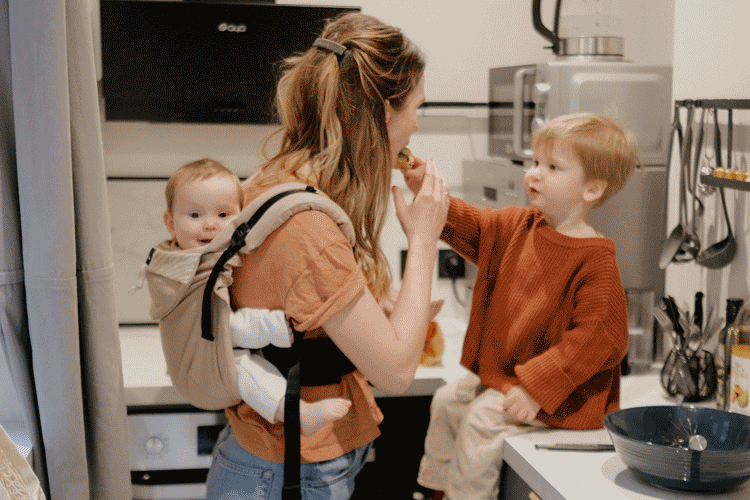
All the times babywearing saved my life!
Single mom in the city, parents on the go or with a large family: Babywearing makes everything easier! For me, babywearing means: Giving him time to sleep , allowing me to share quality time with his brothers and sisters, and yes, no jealousy , we think of everyone! Cook on time so that the siblings don't turn into a gang of hungry little monsters. Have a telephone appointment without interference (You know, the endless 45 minutes with the Caf or social security...) Spending time with my friends and avoiding being isolated, half the evening, in the baby's room . Allowing myself a relaxing break , nestled deep in my favorite armchair, without falling asleep of course Offer my baby a safe space in the crowd and protect him from street stimuli: noise, smell, color (see article on carrying facing the world ) If it can prevent him from having his cheek pinched by the annoying little Grandma "how cute is this baby!" Accompany me during the long nighttime trips up and down the hallway , trying to get the baby back to sleep after a nightmare. You know, when you're so sleepy that the only strength you have left is to move your pelvis to rock the baby and hum a lullaby, which you hope will be effective! It's cheaper than driving around the block, and I even have the luxury of staying in my pajamas ... "Actually, by carrying my children, I did everything" - Camille Have both hands free to: Accompanying my eldest to school without risking a "I don't want to go to school" turnaround Validate the bus ticket and hold on to the bar, while watching over the stroller ! Carry shopping bags and diaper packs (no need to go to the gym!) Continue my hobbies , while spending time with my baby. Go fishing (yes, yes…) Strolling through the undergrowth and picking mushrooms, hiking and reaching the summit via stony paths. Board games with friends, Reading, writing, drawing, Knitting . Volunteer at my local library or community center. Save the price difference with a "high-tech-multifunction-super-plus" stroller, while still allowing for lots of cool tricks. Save space , and allow me to move “light” (compared to the bulky stroller mentioned above) On public transport: train, bus, plane In his apartment In the trunk of the car – no more complicated stroller folding instructions! Facilitate Obstacle crossings Stairs Door openings Sidewalks And even going to the toilet at the station snack bar!
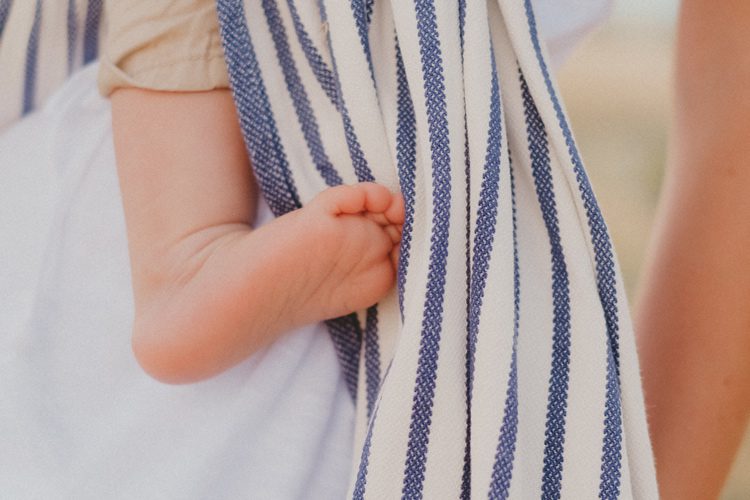
Tips and tricks to optimize the scarf 100%
According to the testimonies of parent users No panic, we're here to support you! You can check out our tutorials to learn from home or get closer to our carrying instructors for more personalized support, which is a real plus to encourage you, and an opportunity for exchange with other parents. And if you still have doubts, here is a list of benefits of the sling, that no other carrying system offers. It is always useful and its options are endless! Imagine a little walk "light mode" and baby is doing well, relaxed, so relaxed that it gives you a gift in the diaper: fold the sling over itself, and it becomes a changing mat! An impromptu nap, it will keep warm like a blanket, in the car or on a small patch of grass, when the older kids are playing in the park, for baby... … Or its parents, because it can also turn into a quilt, on the fly, when mom feels a little cold... A doudou available, a soft fabric with the smell of mom or dad, And even for breastfeeding safely (see tutorial link for the knot) And when baby finally falls asleep in his bed, we roll it into a ball, and it turns into a pillow for parents' nap on the couch. Use the leftover fabric after the knot as a paper towel:Wipe mom's forehead after 3 hours of hiking, while baby naps on her back Mess up baby’s face after a wild snack of a chocolate biscuit. But no, it’s not that dirty! Because another important advantage of the sling is that it washes very easily ! A quick machine wash with the family laundry, and there you go, the job is done! And when baby grows up? Then you can recycle the sling: Throw it on a small table and build enchanted huts; tie it under a table to make a little hammock: perfect for solo reading time; transform it into a small puppet theater curtain, Make a cradle so your growing child can, in turn, play with dolls Or let your creativity run free and even cut it up to make: A tote bag, which will follow you everywhere, as a memory of the cuddly years! Decorative accessories for your little one's room.

Strengthen our little ones' natural defenses with essential oils during winter
Antiviral, anti-infectious…essential oils are particularly effective in fighting winter ailments. They are valuable allies to help the body combat viruses and other illnesses. Especially in children, some essential oils are very useful and allow for natural strengthening and safety. They can be applied as a chest massage or under the feet. However, always be careful to use them diluted and properly dosed! Ravintsara essential oil is a powerful antiviral and is remarkable for stimulating the immune system. Remember to use ravintsara essential oil whenever you want to boost natural defenses. Linalool thyme essential oil is an anti-infectious agent. Linalool thyme is the mildest of thyme oils for fighting all kinds of infections in the most sensitive individuals, especially respiratory infections (rhinitis, rhino-pharyngitis, bronchitis, etc.). Eucalyptus essential oil is a decongestant for the upper respiratory system and also has a stimulating effect on the immune system. Well tolerated by the skin, it differs from the very powerful Eucalyptus globulus essential oil, which is not recommended for very young children. Linalool thyme Ravintsara Eucalyptus
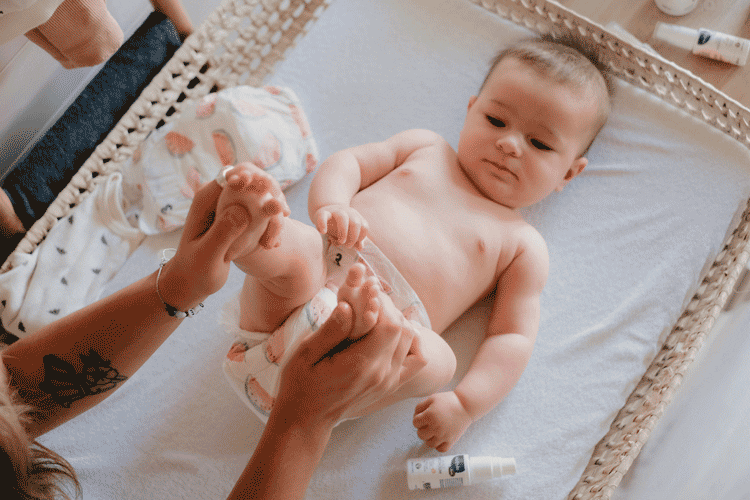
Which essential oils to diffuse to promote sleep in very young children?
Certain essential oils are particularly recommended to promote sleep. They work by allowing relaxation and a return to calm. Their fine and pleasant scent helps reassure and provides a soothing environment for the little ones. We have combined these essential oils into a synergy to be diffused with a diffuser or humidifier: the Relaxation and Sleep synergy. We also offer this synergy in the form of an ambient spray. The essential oils that make up our synergy are: Sweet Orange essential oil: It relaxes and calms. It fights anxiety, nervousness, and improves sleep, especially in children. Its very pleasant citrus scent is loved by children. Red Mandarine essential oil: It is relaxing and fights nervousness and agitation, making it recommended for sleep disorders. It helps relieve anxiety. Marjoram with shells essential oil: It is soothing and rebalances the nervous system. It is useful against nerve fatigue. Fine Lavender essential oil: It is calming and fights sleep disturbances and nervousness. Bitter Orange Bigarade Petit Grain essential oil: It is nerve-rebalancing and calms the mind. Bitter Orange Bigarade Petit Grain Fine Lavender Marjoram with shells Sweet Orange The diffusion can be done for 15 minutes in the room before putting your child to bed. These essential oils have been selected for use in very young children and also in pregnant or breastfeeding women. As a precaution, diffusion is not recommended before 3 months of age. Always ensure to close the bottle after use and keep out of reach of young children, and always air out your interiors.

Simplicity at the heart of the carry
The birth of a baby is an emotional and physical moment of rare intensity. How can one not be amazed and astonished to have succeeded in creating such a perfect little being? He is finally here, in our arms. So tiny. After the tsunami of his arrival has passed, it is still common to suddenly ask a billion questions. Doubt sets in, insidiously. Will I be up to the task? Will I succeed in taking care of him? Which young parent has not felt suddenly crushed by the awareness of the responsibility that falls on them? Responsibility greatly amplified by the societal expectations to do well. Carrying is an excellent revealer of everything that can happen around parenting in terms of involvement and fear of doing wrong. Everyone carries. Yes, yes! When we talk about carrying, we often imagine a baby carrier, but in reality, the first and main carrying in everyday life is done by holding in the arms! Each parent has one or two functional arms, and every baby, at some point or another, needs to be handled, if only to be changed, everyone does it… Then indeed, various tools have been proposed throughout the evolution of the human species, initially rudimentary and increasingly refined. Depending on cultures and traditions, carrying a child can be encouraged, essential, or on the contrary poorly perceived or even discouraged. Sometimes carried swaddled, sometimes not, in more upright or more curled positions, vertical or horizontal, and so on… As soon as you search for information about carrying on the internet, it’s panic! You need to carry physically, with a sling, but beware if the knot is poorly tied, it’s bad for the baby, and if he’s dressed in footed pajamas, no, really, that’s not good… A non-physio baby carrier? But what an horror, it will ruin his spine… Among all this, let’s not forget the famous advice from Aunt Cunegonde, who reminds us that in her time, they didn’t bother with all this, and anyway, they didn’t die from it… and moreover, it will make a spoiled, arm-carrying baby. So, what do we do with babychou? Well, it depends… Primarily on him. Because let’s not forget that he is still the main interested party! Babies all have their own needs; some will love from the start having their little space and splashing on their mat, others, on the contrary, will only calm down when constantly carried by their parents. Neither of the two situations is abnormal, and especially in cases where the child needs more carrying than average, keep in mind that it won’t last forever. We don't know any 15-year-olds in good health who are still carried or pushed around. Birth remains a challenging stage for the newborn who comes from a very contained environment, where they floated in zero gravity in a liquid filtering most stimuli, and where they knew neither hunger, nor discomfort, nor pain. Some need a bit more time than others to acclimate and ask to be a bit more supported. On average, we observe that by around 3 months, most have passed this milestone and are starting to demand to go to the ground. And what about the parent then? Everyone also needs to find their balance in their relationship with the baby. Sometimes it's easier not to question oneself and to respond to the child's needs without thinking, knowing that it will pass. Sometimes it's more complicated to live through and we negotiate with them to find common ground, a compromise... In both cases, there is no rule. No "better" way. The ideal is always to do what suits us and to observe our child. And to accept that needs and responses can vary from day to day because we are not machines (and too bad for Aunt Cunegonde's good advice)! And what do we carry the baby in? Continuing along the same lines, flexibility is key. No study to date has demonstrated increased risks of injuries or malformations related to a so-called "non-physiological" carrying method practiced with a baby who has no underlying pathology. We recommend opting for physiological carrying for comfort reasons, but that's all. The perfect carry does not exist in real life, the only rules to follow are safety rules: carry the baby vertically, with clear airways, and ensuring they won't fall. These are the first objectives to achieve when carrying your little one; the rest is just a matter of comfort. We remind you that behind a pretty photo, there are sometimes many attempts and hundreds of other failed shots! As for baby clothes, it's a matter of common sense: soft and comfortable clothes (who would take a nap in a wedding dress or do yoga in skinny jeans? No one? Then the same applies to baby, ditch the frilly dress and tight pants). And if the pajamas start to be too short and pull on the feet, just change to a bigger size. In short, it's about bringing simplicity back into the equation. Does the baby need to be carried? Let's carry them, as much as necessary for everyone to be satisfied. Does the baby prefer to be laid down? Let's lay them down. The tool suits us and makes our life easier? As long as it respects safety, everything is perfect. Being a parent is undoubtedly the most complex task of our lives, the one that will crystallize all our energy, all our thoughts, and above all our anxieties, for many (decades) years. It is always easy to criticize and judge others' ways of doing things, and whatever we do with our children, it will never be enough! So as long as we are going to mess up, might as well do it wholeheartedly with something that seemed right to us. And incidentally, to build oneself with perfect parents, but what pressure for our children! Carrying in a sling is above all the pleasure of contact with your little one, creating an indestructible bond. No matter the tool or the beauty of the gesture, no one will judge anyone for how well they manage to use a wrap! What matters are the desire, the needs, and that it helps facilitate daily life by reducing tears.
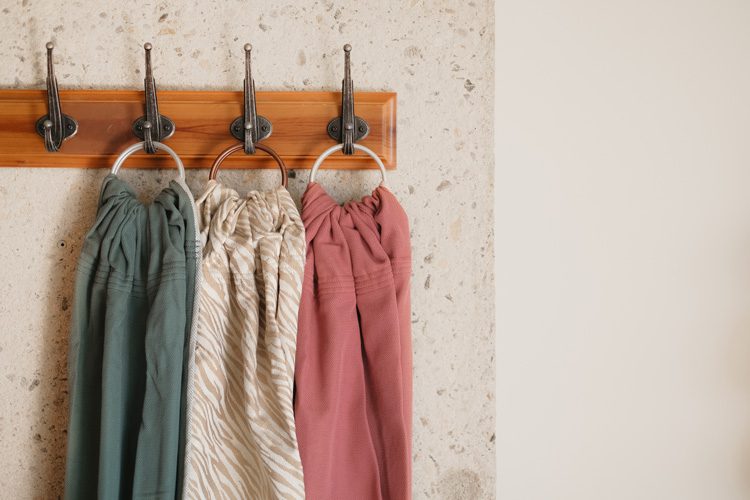
Which material should I choose for my scarf?
In a more supportive and breathable fabric? In a more enveloping knit but less durable? Preferably basic, easy-to-care-for cotton or a firmer linen? Or maybe a bit of viscose to smooth everything out and add a little breeze of freshness? Here you are lost in the jungle of babywearing and the many choices available to you. Need help understanding better? We offer a small article to review the commonly used materials in baby carrier manufacturing and their impact on use. 1 – Fabric or knit? The very first notion to know, the most important, is the distinction between fabrics and knits. Did you think that all wraps were just large pieces of fabric, almost identical? Actually, there are three models divided into two main categories: woven and knitted, with or without elastane! Knowing which category your item belongs to significantly impacts how you will use it! Knit is made from a single yarn, usually cotton, knitted. Of course, not with grandma’s needles: an industrial knitting machine is used. This results in a fabric that is more or less stretchable: take your T-shirt, for example, it’s a knit. Knits entirely made of cotton have a stretch without memory: when you stretch the fabric, it remains deformed afterward. In babywearing, this fabric is pleasant for carrying a newborn but often very little durable: as the baby grows and gains weight, the knit stretches and the child is poorly supported inside, making installation uncomfortable. The thinner the knit, the less supportive it is, if your wrap is so thin that it’s transparent, it’s rather a bad sign for its durability. If the composition label is inaccessible, you can recognize these materials by their behavior: stiff when stretched lengthwise, rather soft and slightly deformed widthwise. Note that the instructions for wraps sold with these wraps often do not match their actual use and suggest impractical knots (notably the "basic knot" style, which is performed entirely before placing the child, but can only be offered with knits containing elastane in combination with cotton). Knits containing a bit of elastane or spandex in addition to cotton (around 5% generally) benefit from a shape memory that allows the fabric to return to its original shape after stretching. These are much more dynamic knits and are therefore more supportive. that their counterparts without elastic. If we want to play on semantics, we can talk about elastic stretchy wrap in addition to extensible. The obtained answer allows the wrap to be used for several months, the actual durability then depends on its width and density, on average we are between 4-6 months and 12-18 months. Knitted Armor Knitted wraps all require 2 to 3 layers of support materials on the baby's back to be safe: simple layer knots like a kangaroo or a crossed-wrapped swaddle with non-deployed panels are not suitable. In most cases, their use for back-carrying is also discouraged. The fabrics are made on a loom, with several warp and weft threads. The weaving used in carrying is what is called twill-weave. We spare you the technical details; basically, when you take a piece of cloth (e.g., a dish towel), it is very stiff when pulled along its length and width, but very stretchable diagonally with a tendency to deform (see the linen pants that seem to grow 4 sizes after 10 minutes of walking? This is due to the deformation of the fabric!). We do not use fabric for making wraps because the rigidity along the lengths tends to cut into the edges and the deformation diagonally is not optimal for providing good support to the baby. It would be safer but less comfortable. The broken twill is less 'dry' in length and width, and elastic diagonally (see for knits if you followed closely: stretchable but with a shape memory that offers more resistance). For example, jeans are made with twill weaving (not broken, but it’s similar!) Woven wraps are very durable, they can withstand traction forces of over 700kg without flinching (Note: if your baby reaches this weight: consult!). A single layer is enough to provide good support for your little one, which especially allows for kangaroo knots. Woven Fabric Armor Jacquard Woven Armor Cross Twill Woven Armor 2 – So, what is better? Is everyone still with me? Let’s continue! The choice between knit or fabric is mainly subjective: carrying is primarily a matter of sensations! Knits provide sensations extremely enveloping, especially those with elastane that give a true second skin effect. You become one with your baby! They are less durable than fabrics but are also less expensive: this can allow at a lower cost to first see if you enjoy carrying before investing in another system that will go further. It is not uncommon to start the first weeks with a sling, then switch to a mei-tai or preformed carrier when the baby grows and/or when you want to carry him on your back with less technical setups. On the other hand, contrary to popular ideas, they are often more technical to handle: when you pull on the material, it deforms before tightening, and it only tightens if you pull in the right direction! The lack of feedback can sometimes challenge a beginner who will have difficulty assessing if their adjustments are correct. Another negative point to consider: they are warm scarves! 3 layers of fabric + the synthetic elastane: beyond 20-25°C, this can become quite uncomfortable! Finally, elastane is a material that has a limited lifespan. Even (and especially) useless in a closet, the sling wears out: do you see the old pair of socks forgotten in a drawer? the elastic that makes CRRRRCCCRCRRRR and breaks when you pull on it? Same thing. At least the sling does not tear and remains safe, but it becomes stiff and much less comfortable. So avoid it occasionally. Fabrics are, on the other hand, very durable and can be used to carry multiple children (or even their own children later on!). The weaving is generally more breathable than knitting, which needs to be very dense to be supportive, and since it is only used in one layer, it is perfectly usable even in the summer (see the article on summer carrying). Woven scarves suffer from a poor reputation of being difficult to handle and a bit stiff: as you will understand, this is not the case! They offer a very pedagogical feedback that allows you to feel the adjustments well, and the signs of good quality are soft and flexible from the first uses. 3 – What about the material? Beyond the notions of yarn work, the composition of the yarn also matters: cotton, linen, hemp, wool, silk, bamboo viscose… You will not get the same result depending on the chosen material! Classically, cotton remains the most used fiber: versatile, soft, lightweight, and easy to wash, it has the ideal characteristics! Linen and hemp are regularly mentioned for summer: if they are indeed cooler, their fibers are also more rigid. This makes the sling a bit stiffer and less easy to adjust. With some exceptions, baby carriers containing linen or hemp are generally intended for heavier toddlers and who stand well enough for their musculature to compensate for less precise adjustments, they are more supportive That is to say, with a thickness equal to cotton, you will feel less the weight of your child with. Silk and wool are materials that are thermoregulators: they keep you warm in winter but stay cool in summer. They are often slightly more elastic than cotton and very pleasant if you can tolerate the somewhat "prickly" side of wool (even if high-quality wools are very soft and have nothing to do with the sweaters and balaclavas that traumatized us as children!). The main downside remains their more delicate maintenance, to be avoided with a baby who regurgitates a lot! Viscose are synthetic materials but generally cool and very fluid. They give scarves great flexibility and are highly appreciated in combination with cotton for carrying very young children and for summer. 4 – Where are the Neobulle ranges located? My sling My sling, My cocoon and My neo are carrying systems made of knitted: they are therefore stretchable and enveloping, designed for carrying in the first year of the baby.My sling is sewn in 100% cotton knit but features a high density that despite being used in a single layer provides quite surprising support! My cocoon My cocoon is made of a blend of bamboo viscose and elastane, making it a stretchy scarf. Bamboo largely reduces overheating associated with the three layers it requires, making it ideal for front carrying only. My Neo My Neo features an apron made of an innovative 3D knit flexible but very supportive. Écharpe sergé brisé coton The vast majority of other ranges are made of cotton either woven with a broken serge weave or jacquard weave: jacquard is a much more complex technique that creates a pattern and is therefore more aesthetic. The resulting fabric is also more flexible, softer, and more pleasant to handle and adjust. Écharpe seacell Finally, the slings and classic range scarves feature a combination of cotton and seaweed viscose, which gives them a great feeling of freshness and more fluidity. All that's left is to choose the colors, and this time: we can't help you anymore!!!!
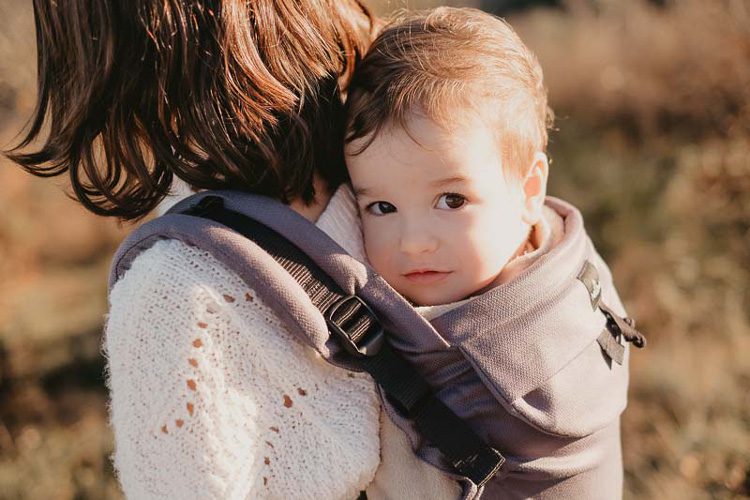
The maintenance of strollers
You've just bought a baby carrier and the care instructions are as obscure as hieroglyphics? Is your sling your only asset for getting your baby to nap, and you don't dare wash it for fear of making a mistake (but you really have to)? This article is for you! We'll give you all our little tips for pampering your equipment.
